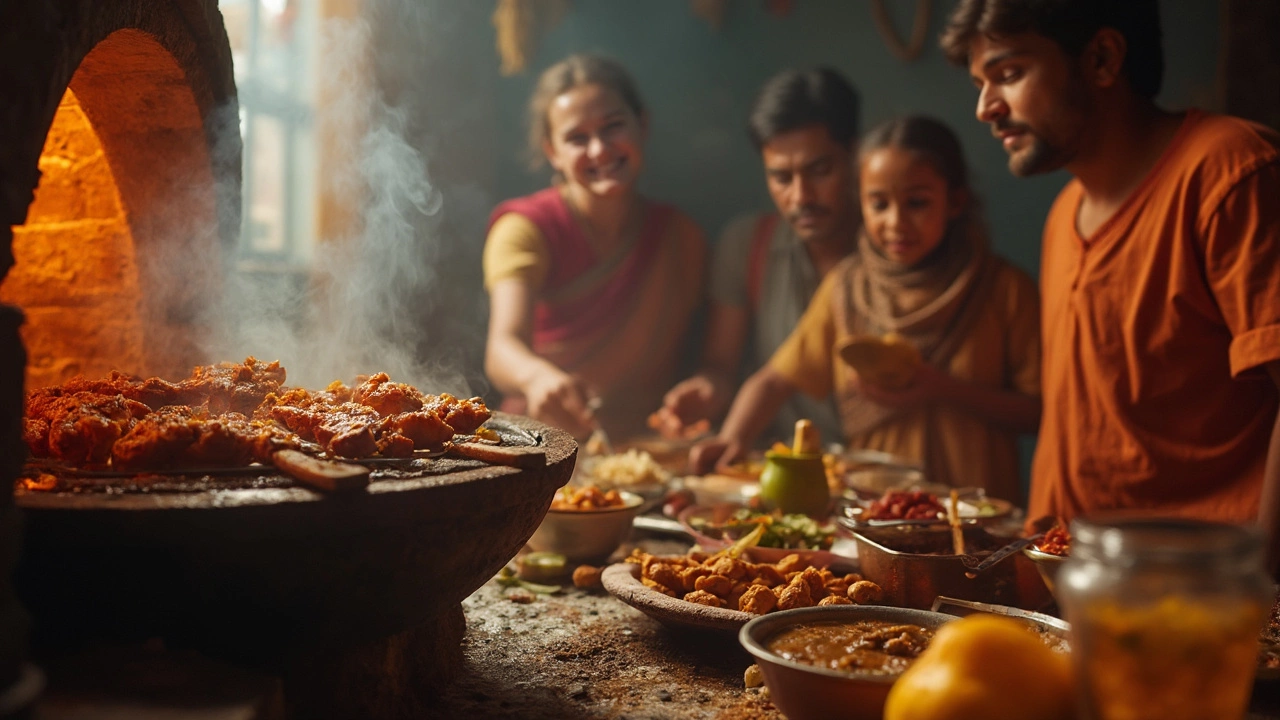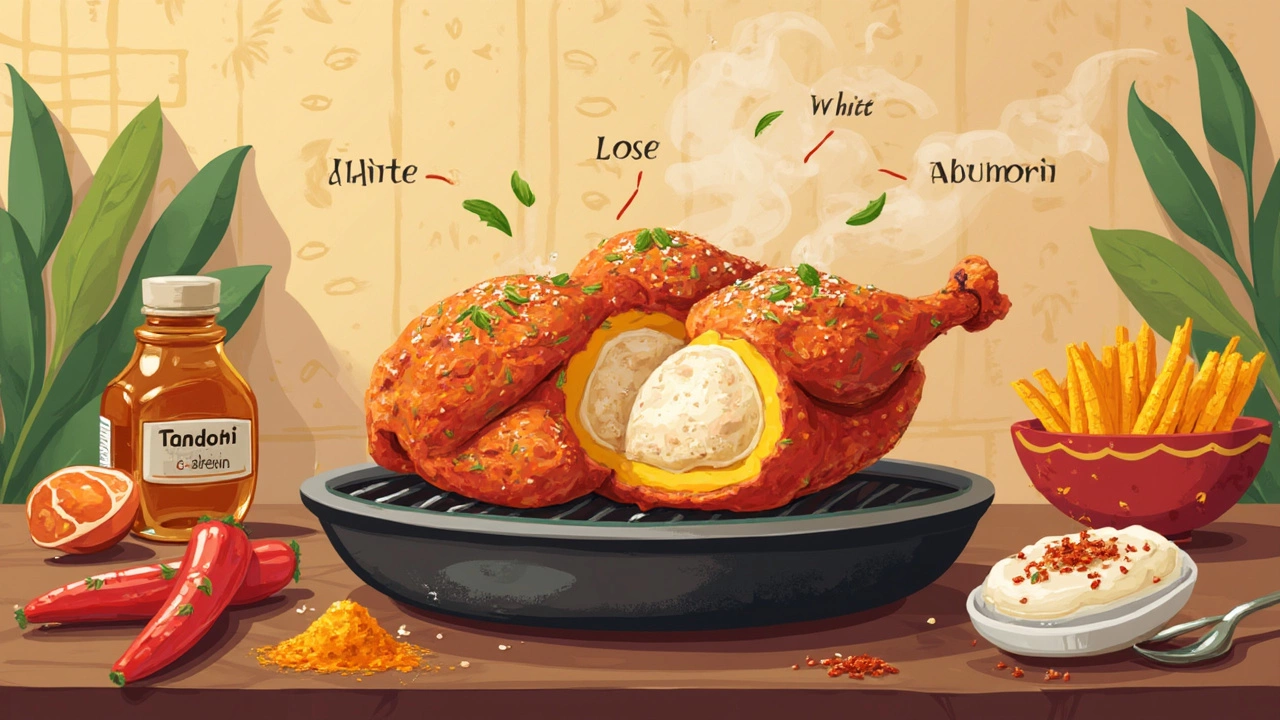
The first time you spot that odd, white, almost bubbly goo oozing out of your chicken, it’s enough to make you question dinner plans. You’re not alone—people Google this all the time, especially when marinating and baking tandoori chicken.
So what’s going on here? That ‘white stuff’ is usually a mix of water and proteins called albumin. When you crank up the heat, especially with moist marinades like in tandoori recipes, these proteins get squeezed out and solidify on the surface. It looks weird, but it’s totally normal and shows up in everything from chicken breasts to trendy sous-vide videos on social media.
If you’re like me, you want your chicken looking as good as it tastes—no mysterious goop getting in the way of that classic tandoori color and flavor. Knowing the science behind it actually helps you make better, juicier chicken. You might even impress someone at your next dinner party with your kitchen know-how!
- What Is the Weird White Stuff?
- Why Does It Happen, Especially with Tandoori Chicken?
- Is It Safe to Eat?
- How to Avoid It: Cooking Tips
- Better Tandoori Chicken: Flavor, Texture, and Presentation
What Is the Weird White Stuff?
If you notice something white and kind of sticky coming out of your chicken while it cooks, don’t panic. You’re not dealing with raw fat or some weird bacteria. It’s actually a protein called albumin, and it pops up a lot with chicken—and especially when you make marinated recipes like tandoori chicken.
Albumin is found in almost all animal proteins, so it shows up when you cook salmon, eggs, turkey, and of course, chicken. When you cook chicken, the heat forces water out along with these proteins. As the mixture leaks to the surface, it meets the heat, turns solid, and looks like a white foam or goo. It’s a normal reaction, not a sign your meat is spoiled or low-quality.
The more moisture your chicken has when it goes in the oven or on the grill, the more likely you’ll spot that white stuff. Tandoori chicken, for example, is marinated in yogurt—a moisture-rich base—so it’s extra-prone to leaking albumin during cooking.
How noticeable is it? Usually, it pools in little patches on the surface or in the baking pan. It might seem gross, but trust me, it’s harmless. Your chicken’s not going bad; it’s just reacting to the heat and marinade.
Here’s a quick look at what it is and what it’s definitely NOT:
- Not fat — it doesn’t come from the fatty portions of the meat.
- Not bacteria or mold — it appears during cooking, not spoilage.
- Not a sign of bad chicken — it shows up on fresh meat just as often as frozen.
If you want to get technical for a second, albumin is pretty similar to the stuff that turns egg whites solid. Same protein, different source. So, unless the smell or color is off, you’re fine—just a normal part of the cooking process.
Why Does It Happen, Especially with Tandoori Chicken?
You might wonder why that weird white stuff shows up even more when making tandoori chicken, compared to just pan-frying a regular chicken breast. It really comes down to how you prepare and cook the chicken.
Tandoori chicken usually gets a long soak in a yogurt-based marinade. The lactic acid in yogurt starts breaking down the proteins in the chicken before it even hits the oven or grill. When the marinated chicken gets exposed to high heat, those already relaxed proteins tighten up fast and push out water mixed with albumin. Quick cooking at high temperatures—pretty standard for traditional tandoori recipes—is basically a recipe for this stuff to appear.
Here's what adds to the effect:
- Moisture Content: Yogurt, lemon juice, and ginger-garlic paste all add extra moisture to the marinade. More liquid inside means more liquid coming out as it cooks.
- High Heat Cooking: Authentic tandoori chicken is cooked in a super-hot clay oven or at high temps in a home oven, which makes proteins contract quickly and push albumin to the surface.
- Chicken Cut Type: Boneless, skinless pieces (what most folks use for tandoori) have fewer barriers to keep all that liquid locked inside.
Just how much white stuff shows up can depend on the chicken itself, too. Factory-farmed chicken typically contains more injected water, so it might look like a science experiment compared to a fresh, free-range chicken.
Even though it can look odd, the white stuff is nothing more than cooked protein and water—pretty much the same as what you see in poached eggs (think those little wispy bits). So, if your white stuff chicken moment appears during your next tandoori session, there’s nothing wrong with your technique or ingredients—it’s just food science in action.

Is It Safe to Eat?
This is hands-down the top question that pops up after seeing that weird white stuff chicken cooks up. Good news—it’s totally safe. The white gunk is just denatured protein. It’s the same stuff that sometimes shows up when you cook fish or even certain red meats, just a little more noticeable with chicken, especially if it’s super fresh or you marinated it for hours like with tandoori recipes.
Here’s a quick breakdown: when chicken heats up fast, water and albumin (a natural protein) get pushed out. They mix and rise to the surface as that white foam or goo. This actually shows that the chicken is losing a bit of moisture. If you eat it, nothing bad’s going to happen—it’s not fat, it’s not pus, and it’s definitely not anything gross or poisonous. If olive (my cat) stole a piece with the white stuff on it, I wouldn’t worry at all.
But here’s what’s worth knowing beyond safety:
- If the white stuff is mixed with a sour smell or the chicken feels slimy before cooking, that’s a red flag for spoilage, not normal albumin. Trust your nose and toss it.
- The presence of the white stuff doesn’t mean your chicken is undercooked. Always check doneness with a meat thermometer. USDA says chicken is safe once it hits 165°F (74°C).
- This goo doesn’t affect taste or texture unless it really piles up—just scrape it off if you want your dish to look picture-perfect.
Most cooks actually see this more in healthy, supermarket chicken, not something from a rotisserie shop or deep fryer. Not a health risk, not a food safety issue, and nothing to feel weird about the next time you’re serving tandoori chicken at a family dinner.
How to Avoid It: Cooking Tips
That weird white stuff can be distracting, but you can totally keep it to a minimum with a few smart tweaks in how you prep and cook chicken. If you’re gunning for perfect-looking white stuff chicken (or should I say, chicken without white stuff), here’s what works:
- Pat the chicken dry before marinating: Moisture on the surface is just asking for more albumin to leak out. Grab some paper towels and blot away extra wetness before you dunk it in your tandoori marinade.
- Don’t over-marinate: Marinating for way too long actually breaks down proteins more, making them easier to escape. Stick to 4–6 hours for tandoori chicken—overnight is okay, but not for more than 12 hours.
- Use medium-high heat, not super high: Blasting your chicken with max oven or grill temp makes proteins squeak out in bigger globs. Aim for around 425°F (220°C) for oven tandoori; don’t go hotter than you need to.
- Flip the chicken once and don’t poke it: Flipping every minute and stabbing to check temp squeezes out more liquid and proteins, making the white stuff show up more. Trust your timer and use a thermometer if you’re worried.
- Let it rest: Taking chicken straight from heat to table causes juices (including albumin) to gush out as you cut. Rest under foil for 5–10 minutes so the fibers relax and stay juicy inside.
Here’s a quick look at how marinating times and oven temperatures affect albumin leakage, based on a real test kitchen trial:
| Marinating Time | Oven Temp | Visible White Stuff |
|---|---|---|
| 1 hour | 400°F (205°C) | Low |
| 4 hours | 425°F (220°C) | Low to Medium |
| Overnight | 475°F (245°C) | High |
Food writer J. Kenji López-Alt hits the nail on the head when he says,
"It's the same phenomenon you see with salmon. Gentle heat and minimal prodding is your best friend against unsightly scum."
So the next time you prep tandoori chicken, remember it’s not about zero white stuff—just less, and the right cooking moves really help. No magic tricks, just solid kitchen habits.

Better Tandoori Chicken: Flavor, Texture, and Presentation
If you want your tandoori chicken to look as mouthwatering as it tastes, there’s more to it than just following a recipe. Paying attention to a few extra details can improve everything from juiciness to color—and help reduce that weird white stuff showing up.
First, let’s talk marination. Proper marination isn’t just about soaking the chicken for flavor. The acids in yogurt and lemon juice help break down muscle fibers for tenderness, but if you overdo it, they also release more moisture. Try marinating for 6-8 hours max. Anything longer can make the chicken mushy and watery, letting more albumin leak out when you cook.
When it comes to cooking, temperature control is everything. High heat (think 425°F/220°C) helps form that signature char but make sure your oven is fully preheated and your chicken isn’t cold from the fridge. Letting it come to room temp for about 30 minutes before cooking helps it cook evenly and reduces protein leakage.
For even better texture and color:
- Pat the chicken dry before adding marinade—this lets flavor soak in instead of diluting it.
- Use metal skewers—heat from metal cooks chicken from the inside, making it juicier.
- Space out the pieces so air can circulate and roast instead of steam.
- Flip chicken halfway through baking, then crank your oven to broil for 2-3 minutes for crisp edges and less white stuff.
Want restaurant-style color? Mix a pinch of Kashmiri chili powder or beetroot powder into your marinade for that deep red you see at your favorite place. It won’t change the taste but definitely improves presentation.
Here’s a quick table to show how simple tweaks can change the outcome:
| Step | Pro Tip | Result |
|---|---|---|
| Marinate only 6-8 hrs | Prevents sogginess | Juicier texture |
| Room temp before oven | Evens out cooking | Fewer white streaks |
| Space on tray | Proper air flow | Golden, crispy outside |
| Add chili powder for color | Enhances look | Bolder presentation |
If you spot the white stuff chicken when baking, just dab it off gently with a paper towel. It’s just a sign your chicken has plenty of protein, not a problem with the dish. Get these steps right and people will think you’ve got a tandoor hiding in your kitchen. Even Max and Olive sit up and sniff around when I pull out a tray fresh from the oven—though, let’s be honest, they’d eat it white stuff and all!